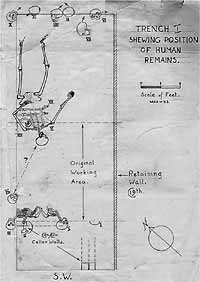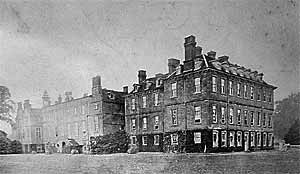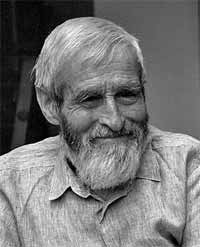News for Autumn 2015
LIFE AND DEATH IN MEDIAEVAL NOTTINGHAM


Multi-disciplinary research, involving an international team of experts, is being undertaken into a burial ground located in Nottingham city centre, which aims to unlock important information in a project entitled ‘Life and Death in Mediaeval Nottingham.’
Excavations by amateur archaeologists in 1963 form the basis of the project, which is funded by the Council for British Archaeology (including the East Midlands branch of the CBA) and Nottingham City Museums and Galleries. The project is managed by Nottingham archaeologist Scott Lomax. The excavations, by Tony Wass and members of the Thoroton Society in advance of the construction of Cranbrook House, and a number of preliminary hypotheses explaining the burials, were the focus of a paper in the 2010 Transactions. Since the publication of this paper, much research has been undertaken which has advanced our understanding of the site.
Photographs appearing to show the decayed remains of a coffin, with handle, caused confusion and had led some to conclude the burials were of a post mediaeval date. However, it has now been established that these photographs were taken during the lowering of ground levels at the rear of the Ideal Homes Store, which occurred in the weeks prior to the Cranbrook House excavation. The Ideal Homes Store was located on the site of Hockley Chapel, a Methodist chapel with burial ground. The clearance of burials in the early 1960s also explains why archaeologists from the University of Leicester found only two human skeletons during their excavation of the site in 2004.
In 2013 samples from the two surviving individuals from the Cranbrook House site were radiocarbon dated. The first sample from individual SKV dated (with 95.4% probability) to between 1454 and 1633 calAD. There was a slightly higher likelihood (50.6% probability) that it dated to between 1454 and 1526 calAD than 1556 to 1633 calAD (44.8% probability). The second sample from individual SKVa gave a date (with 95.4% probability) of between 1415 and 1450 calAD. The dates suggested the possibility that the individuals were buried at two different points in time rather than in one mass burial, as was originally believed, but that the burial ground was certainly in use during the early to mid-15th century and possibly beyond that time. Documentary evidence strongly suggests the burial ground had ceased to be used by the 16thcentury and was quickly forgotten about.
The dead at Cranbrook Street were buried at varying alignments, contrary to Christian custom, with at least one individual buried at a right angle to a skeleton immediately beneath. It appeared they had been carelessly buried, as if in haste. The project now aims to understand the circumstances necessitating burials outside the medieval town at a time when five burial grounds were in use within the mediaeval town: burial grounds at the churches of St Mary, St Peter and St Nicholas, and the Carmelite and Franciscan friaries. The burial ground at St John’s Hospital, located north of the town, had, according to historic documentation, ceased to be used by the time of the Cranbrook Street burials.
One hypothesis, supported to a certain extent by documentary research, is that the dead were victims of an epidemic, or a series of epidemics, during a period of urban decline which saw abandonment of the area east of St Mary’s Church following the Black Death of 1349, dereliction of property by 1374, increased poverty by
1409 and led to Nottingham being described as an ‘impoverished town’ by 1433/1434. The earliest burial records for Nottingham date to 1563. However, documentary research undertaken during this project, using methods never previously applied to studies of Nottingham’s past, has suggested the likelihood that Nottingham, and other parts of the county, were visited by some form of epidemic in 1409/10, 1435-1437, 1442, 1445, 1451/52 and 1461/62. Possible epidemics occurred occasionally for the remainder of the 15th century and into the 16thcentury. In 1518 Henry VIII was advised not to visit Nottingham because there was ‘some death’ in the town. A paper is being prepared detailing these findings.
An osteoarchaeological examination has identified interesting characteristics of the remains, providing clues relating to the occupation and lifestyle of the two individuals. A facial reconstruction has been produced, to bring people face to face with a man living in Nottingham approximately 600 years ago.
Stable isotope analysis has revealed information about the place of birth of one of the individuals, and information regarding the diet of the second individual. Ongoing research, to be completed by the summer of 2015, includes ancient DNA analysis to test for up to 3000 bacterial, viral and fungal pathogens and further documentary research is planned. A team of international experts from Nottinghamshire, Canada and the USA are involved in the scientific analysis. For further information about the project please visit
www.medievalnottingham.sclomax.co.uk
Scott Lomax
RUFFORD ABBEY: AN EARLY PHOTOGRAPH

As my recent article* was going to press I came across an old photograph of Rufford Abbey in the Nottinghamshire Archives whilst looking for early photographs of Newstead Abbey. Tucked away at the back of an album entitled ‘MANSFIELD 1900’ I found this photograph of Rufford Abbey from the north-east, which I had never seen before. It shows the house before the new grand staircase was added to the east front and the bay window was added to the north front. This new staircase, housed in a projecting gabled wing at the centre of the east front, and the first-floor bay window on the north front, have always been referred to as having been added as part of Anthony Salvin’s alterations to the house carried out between 1837 and 1841. This would have meant that the photograph was taken before Salvin began his alterations in 1837, and this would have meant that I had discovered one of the very earliest photographs ever taken! I immediately and excitedly consulted Ian Leith at the National Monuments Record in Swindon who assured me that this photograph could not possibly date from this early and he suggested that it dated from the 1870s at the earliest and that these additions must have been made after this date.
Eventually having re-examined the various documents which relate to the history of Rufford, I discovered in the 2nd Lord Savile’s article Rufford Abbey, published in The Pall Mall Magazine in 1898, the following solution to my problem:
‘The grand staircase, of carved oak, was designed and built by the late Lord Savile, H. M. Ambassador at Rome; the fine bay window, which forms the first floor landing, being the only addition to the outside of the house since the alterations made by Lord Halifax.’
The late Lord Savile referred to must be John Savile, 1st Baron Savile (1818-1896) the diplomat and amateur artist, who inherited Rufford Abbey in 1887 and died in 1896. So we now know that this grand new stair and the bay on the north front were not part of Salvin’s work, instead they were constructed sometime between 1887 and 1896. This means that the photograph which began this enquiry does, as Ian Leith suggested, date from the 1870s or 1880s.
So this picture is not the early photographic image I first imagined, but it is nonetheless an extremely important image for the history of Rufford Abbey. As a consequence of this discovery I have written a third article for the English Heritage Historical Review entitled Rufford Abbey; A Victorian and Edwardian Country House which discusses this and other new evidence concerning the architectural development of Rufford Abbey.
Pete Smith (pete21smith@gmx.com)
* Smith, P. (2013) Rufford Abbey and Ollerton Hall, Nottinghamshire: Alternative Interpretations, English Heritage Historical Review 8(1) 18-35
FRIENDS OF NOTTINGHAM MUSEUMS
The Friends of Nottingham Museums was established in 1977, with the objective of providing support to Nottingham City Council's museums and galleries. They raise funds to enable the purchase of new items for the collections, assist in volunteer projects, work at events and lead tours.
The Friends are a group of like-minded people with a pride in Nottingham and its heritage. With the desire to promote the importance of the city's museums, they devote time and effort to the continued development of these historic sites.
The benefits of being a Friend include:
- Free admission to all museums (special events may incur a charge)
- Invitations to all Private Views and Exhibitions
- Copies of the Nottingham City Council 'What's On' guide
- Copies of the 'Friends' quarterly newsletters
- Guided and illustrated talks with Museum and Galleries staff
- 10% discount off all purchases made in museum shops over the value of £5
- Involvement in museums events
- A varied programme of lectures, illustrated talks and visits to galleries and historic places
Lectures are held on Saturdays in Studio 1 at Nottingham Castle, 2pm prompt. The programme until February 2016 is:
19 September Museums and Galleries talk (members only)
17 October Edward Carver, a Victorian hatter and furrier - Peter Hammond
14 November Notable men and women with Nottinghamshire connections - Barbara Bradley
12 December Christmas Crackers - Janette Merilion
16 January Development of Newark Civil War Centre and Newark Museum - Kevin Winter
10 February AGM followed by a talk from a member of the City Museums’ staff.
Non-members are welcome to attend any meeting (except 19 September which is members only) at a charge of £2 (normal entry to The Castle applies). Further information from Janet Lievesley 0115 922 1734.
OBITUARY Christopher Francis Kendal Granger 1935-2015

It is with much sadness that we report the death of Christopher Granger. A long-standing member of the Society, Chris was very much a Nottinghamshire man, with close connections to several well-known Nottinghamshire families. On his father’s side, he was a great-grandson of Sir John Turney, leather manufacturer and Lord Mayor of Nottingham, and a great nephew of Professor Frank Granger of Nottingham University. On his mother’s side, he was descended from Richard Warwick, founder of the Warwick and Richardsons Brewery in Newark, and related to the Huskinsons of Langar Hall.
After National Service in the Royal Artillery, Chris joined the family firm of accountants. But shortly after qualifying as a chartered accountant in 1961, he had the catastrophic misfortune of an accident in the Noel Street Baths, which left him with a severe spinal cord injury. Only the excellent care he received from Stoke Mandeville Hospital saved his life. It was here that he met his future wife Eileen, whom he married in 1964. Her skill and constant care kept him astonishingly fit both physically and emotionally through the years that followed. The arrival of the two children added an extra and hugely happy dimension to their lives, in turn much increased by the arrival of four grandchildren.
Not entirely happy with his job in the national firm of accountants which had taken over the family partnership, Chris boldly set up on his own accountancy practice, and made a considerable success of this.
He also served on the Board of the family firm of lace makers, Nottingham’s last independent lace manufacturers.
This did not prevent him from pursuing an amazingly wide range of spare-time interests both historical and other. He and Eileen were often to be seen in Nottingham’s “theatreland”, attending plays, concerts and opera. And these were complemented by visits to London and elsewhere. Indeed, determined not to be constrained by Chris’s condition, they frequently holidayed abroad. Nor was gardening out of the question. Chris’s great love and knowledge of plants led them to create a garden with an extraordinarily wide range of species.
He had long had a substantial collection of coins. To this over time he added one of seventeenth century tokens, and became perhaps the foremost expert on the tokens of the East Midlands. He explored his family’s history in numerous lines, one of which went back to John Robinson of Pilgrim Father fame. He also found time to research and write up the history of Hickling Church, being on the final stages of this at the time of his death.
Chris’s quiet and gentle manner was unchanged by his accident. A man of great intelligence, he held strong views but did not shout about them or force them on others. A life-long Liberal, he castigated the Conservative treatment of the disabled. In a marvellous example of his determination not to be dominated by his condition, he threw a party to celebrate the 50th anniversary of his accident and the start of his life in a wheelchair. That he survived 53 years after his accident is extraordinary and a tribute to the wonderful care and love he received from his nearest and dearest and the exceptional physique and determination of the man himself. He is sorely missed.
John Hamilton